26 Creatures Suffering From Albinism

Albinism humans is a congenital disorder characterized by the complete or partial absence of pigment in the skin, hair and eyes. It is associated with a number of vision defects, such as photophobia, nystagmus, and amblyopia. Lack of skin pigmentation makes for more susceptibility to sunburn and skin cancers. In rare cases such as Chédiak–Higashi syndrome, albinism may be associated with deficiencies in the transportation of melanin granules. This also affects essential granules present in immune cells leading to increased susceptibility to infection.
Albinism results from inheritance of recessive gene alleles and is known to affect all vertebrates, including humans. It is due to absence or defect of tyrosinase, a copper-containing enzyme involved in the production of melanin. It is the opposite of melanism. Unlike humans, other animals have multiple pigments and for these, albinism is considered to be a hereditary condition characterised by the absence of melanin in particular, in the eyes, skin, hair, scales, feathers or cuticle. While an organism with complete absence of melanin is called an albino an organism with only a diminished amount of melanin is described as leucistic or albinoid. The term is from the Latin albus, “white”.
In humans, there are two principal types of albinism: oculocutaneous, affecting the eyes, skin and hair, and ocular affecting the eyes only.
There are different types of oculocutaneous albinism depending on which gene has undergone mutation. WIth some there is no pigment at all. The other end of the spectrum of albinism is “a form of albinism called rufous oculocutaneous albinism, which usually affects dark-skinned people.”
According to the National Organization for Albinism and Hypopigmentation, “With ocular albinism, the color of the iris of the eye may vary from blue to green or even brown, and sometimes darkens with age. However, when an eye doctor examines the eye by shining a light from the side of the eye, the light shines back through the iris since very little pigment is present.”.
Because individuals with albinism have skin that entirely lacks the dark pigment melanin, which helps protect the skin from the sun’s ultraviolet radiation, their skin can burn more easily from overexposure.
The human eye normally produces enough pigment to color the iris blue, green or brown and lend opacity to the eye. In photographs, those with albinism are more likely to demonstrate “red eye,” due to the red of retina being visible through the iris. Lack of pigment in the eyes also results in problems with vision, both related and unrelated to photosensitivity.
Those afflicted with albinism are generally as healthy as the rest of the population (but see related disorders below), with growth and development occurring as normal, and albinism by itself does not cause mortality, although the lack of pigment blocking ultraviolet radiation increases the risk of melanomas (skin cancers) and other problems.
Source : wikipedia

